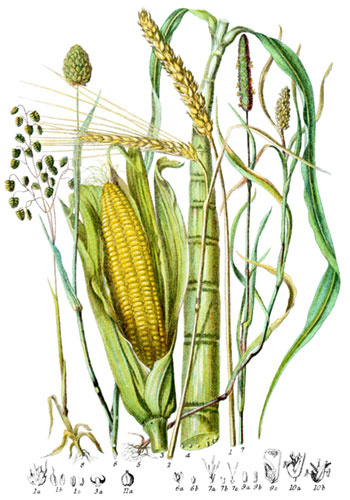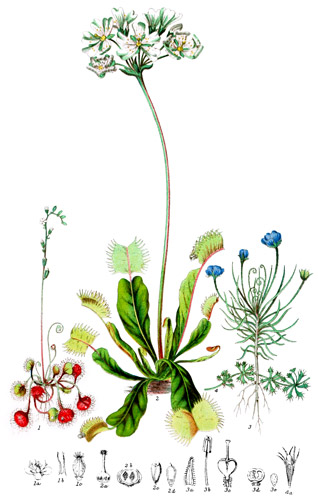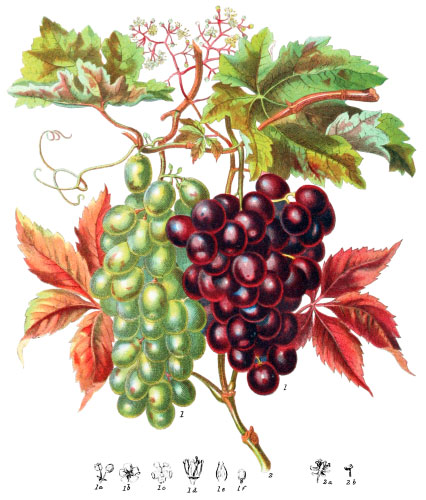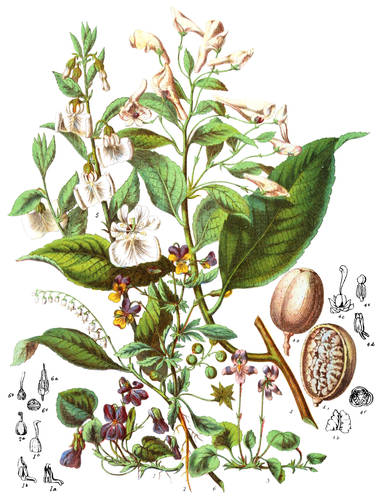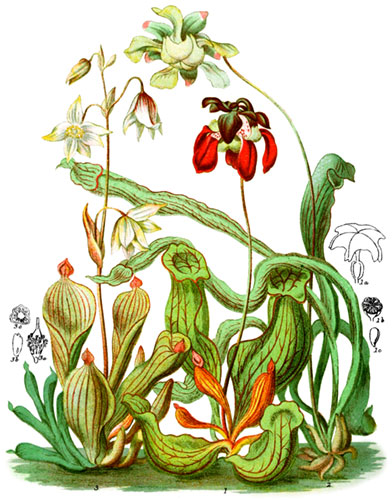Key characteristics
Trees and shrubs, with simple leaves growing alternate on the stem, without stipules. The flowers are usually of a pale-green colour, or brown, growing from the base of the leaf-stalk, solitary, or two or three together. The calyx is composed of three sepals, in most cases partly cohering together. The petals are very rarely wanting. The stamens are of indefinite number, placed closely together, having short angular filaments, and anthers sometimes bearing honey at their angular base. The styles are short, and the stigmas simple. The fruit is composed of many carpels, which are either succulent or dry, sessile or stalked, united in a fleshy mass, as in Anona, or separate, as in Guatteria.
Bocagea forms a link between this Order and Berberidaceæ.
Powerful aromatic properties prevail throughout these plants.
Select plants in this order
Not all plants listed are illustrated and not all plants illustrated are listed.
- Anona squamosa (1) is the common custard-apple of the West Indies; its agreeable and succulent fruit is the daily food of the natives; but it is an acquired taste to Europeans to relish their peculiar flavour. The leaves have a disagreeable odour, and the seeds contain a highly acrid juice, fatal to insects.
- Anona cherimolia (the famous Cherimoyer of Peru) is said to be one of the most delicious of the fruits.
- Anona muricata, the Soursop, is very abundant in Jamaica; the flavour of the fruit resembling that of the European black currant.
- Several species of Guatteria (2) are common in Java; the fruit of these, as also of Polyalthia, passes through various changes of colouring during the process of ripening.
- Polyalthia subcordata has white flowers, much like those of the orange in appearance. The branches of red and purple fruit of the size of currants, and the long leaves of a grey hue on the under-surface, combine to render it a very beautiful tree.
- Some species of Uvaria havea green hairy fruit; that of Uvaria febrifuga affords a medicine in South America; the bark of Uvaria tripetaloidea yields a fragrant gum.
- Xylopia aromatica is known by the name of Ethiopian pepper, and is eaten by negroes in Africa.
- Xylopia glabra is of extreme bitterness in every part of the plant.
- Xylopia sericea is a large tree in the forest of Rio Janeiro; it bears an aromatic fruit, used sometimes instead of pepper; cordage is prepared from the fibrous bark.
- The flowers of Artabotrys odoratissima are extremely sweet-scented; the fruit grows in clusters, and is of the size of a walnut; the leaves are used in medicine. Almost every part of these plants is of utility to the natives of the countries where they grow, particularly in Brazil.
- Duquetia quitarensis of Guinea is the lancewood used by coachmakers for the shafts of light carriages, for which purpose it is excellent.
Locations
This order is dispersed throughout the tropical region of the world; a few of the plants extend beyond them; some have been naturalised in remote stations by cultivation in colonies, especially the Custard-apples and Cherimoyer. Three species of Anona have now become general in India. Guatteria, Uvaria, and Artabotrys, also grow there; a few species are scattered as far as 45° of North latitude on the hills about Monghir, on the Ganges, in Hindostan.
Legend
- Anona Squamosa, Custard-apple, or Sweet-sop. South America.
- Section of a Seed.
- Gutteria lateriflora. Java.
- Flower, cut open.
- Stamen.
- Pistil, magnified.
- Seed.
- Fruit, cut open.
Explore more
Posters
Decorate your walls with colorful detailed posters based on Elizabeth Twining’s beautiful two-volume set from 1868.
Puzzles
Challenge yourself or someone else to assemble a puzzle of all 160 botanical illustrations.

